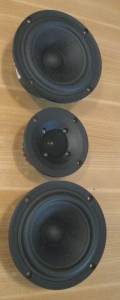I’ve spent a long time thinking about what drivers would be suitable build my TDL RSTL M. While it changes frequently, here is my current thinking as of Feb 2012.
Overview
A real challenge has been finding high impedance drivers. We live in a 4 ohm world. That is fine when you use a single driver per speaker, but the RSTL uses dual woofers, mids and tweeters. Wiring in series is an option, but that comes at a high price in efficiency. A nominal 2 ohm load seems too bruising to me, especially since the crossover is likely to make it even lower at certain frequencies. For the woofers I had no choice, but for the others I went with 8 ohm drivers.
I also agonized over insisting on metal mids and tweeters to match the “M” version of the RSTL. That is what the “M” stands for – metal. So far I’ve come to the conclusion I’m going to use the best drivers I can find for the application, regardless of material. I think that is what Wright would do. He used metal drivers for the mids and tweeters because those were the best available to him at the time. If there were something better, he would have used them.
Woofer
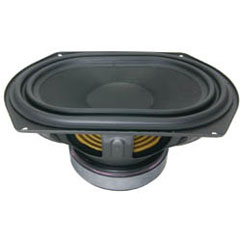
Tang Band W8Q-1071F – a serious sub
There is only one approximately 300 mm x 210 mm format woofer I could find – the Tang Band W8Q-1071F. There are several problems with this woofer – first it is not being imported to the US anymore. In fact, I only have three currently. Does anyone have one they’d like to sell me? Perhaps it is not even being made? Second, it is a 4 ohm woofer. I’m not sure yet if I’ll wire it in series or decide the amp will need to drive a 2(?) ohm load. We’ll just have to see.
A brilliant design move on the part of Wright was to use two different woofers. While they looked identical from the outside, one was a 16 ohm driver, the other 8 ohm. That allowed them to work in different ranges while not adding complexity to the crossover. It is not clear yet if or how I might achieve a similar result with the Tang Band.
Another BIG problem I’m facing is the depth of the W8Q. The originals were about 110 mm deep; the W8Q is a whopping 279. I’ll clearly need to rearrange the internal baffling to make room for the extra depth.
Other drivers considered
- NOS originals if I could find them
Midrange
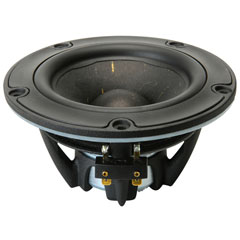
The NE123W-08, a new 4″ “full range” from Vifa
The midrange I’m really struggling with at the moment. I keep going back and forth, up and down. Because of the narrowness of the front section of the cabinet, I’m pretty much limited to 5″ drivers (the original calls for a 13 cm driver – almost 5-1/8″ external diameter for us Yanks). The cutout diameter needs to stay under 4″. The new Vifa NE range blows everything else out of the water at the price, at least on paper. The NE123W-08 is the right size and 8 ohms.
Other drivers considered
- Dayton RS125-8 (cheap, metal and low distortion)
- Peerless – several 4″ models
- SB Acoustics (where did the 8 ohm 4″ go?)
- Scanspeak Discovery 4.5″
- Seas L12
- Tang Band Titanium 4″ (Neo and regular)
Tweeter
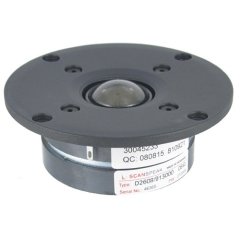
Scanspeak D2608/9130 8 ohm tweeter
As I mentioned, the TDL RSTL uses two tweeters in parallel, so I focused on 8 ohm tweeters. I thought about find high-efficiency 4 ohm tweeters in series, but that did not seem as satisfying. While the Scanspeak D2608/9130 is certainly not cheap, Zaph|Audio says, “Peerless finally creates a world class tweeter to compete with the best from Seas and Scan-Speak.” In case you were wondering why a have a quote about a Peerless tweeter in a discussion about a Scanspeak, the D2608/9130 was formerly known as the Peerless HDS 810921.
Other drivers considered
- Dayton Reference RS28A-4 (Aluminum) and RS28-F (Silk) – both 4 ohm
- SB Acoustics SB29RDC and SB25AC – 4ohm
- Seas – several models – almost all are 6 ohm
- Usher 9950-20 – my second choice?
Supertweeter
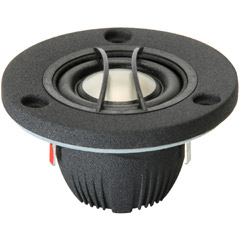
Vifa NE19VTC-04 3/4″ Deep Anodized Aluminum supertweeter
The TDL RSTL uses only a single supertweeter, so here I feel pretty comfortable (finally!) with a 4 ohm driver. The TDL RSTL is designed to be angled such that the speakers cross in front of the listener. So the job of the supertweeter is to provide excellent off-axis response. Most any top-quality, modern tweeter is sufficient on-axis, but for the supertweeter I needed something with excellent response at 30 degrees off-axis as well. That pretty much dictates a 3/4″ tweeter. After pouring over every factory response plot of a 3/4″ tweeter with a small flange (that ruled out great tweeters like the Hiquphon and Vifa XT19 ring radiator), I decided on the Vifa NE19VTC-04. Vifa has a whole series of tweeters with that frame – Silk, Aluminum, Titanium and “Deep Anodized Aluminum”. The NE19VTC-04 is made of this latter material. The supertweeter is only used from about 10K up and this was the flattest off-axis in this range.
Other options considered
- SB Acoustics SB29RDCN ring radiator
- Scanspeak Illuminator R3004 – price!
- Vifa – the other NE series 3/4″ models
35.091074
-106.566226


